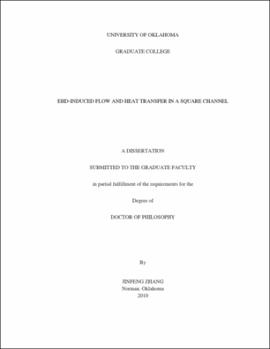| dc.contributor.advisor | Lai, Feng C | |
| dc.creator | Zhang, Jinfeng | |
| dc.date.accessioned | 2019-04-27T21:36:33Z | |
| dc.date.available | 2019-04-27T21:36:33Z | |
| dc.date.issued | 2010 | |
| dc.identifier | 99339074402042 | |
| dc.identifier.uri | https://hdl.handle.net/11244/319143 | |
| dc.description.abstract | Induction of a fluid flow within a square channel using electrohydrodynamic | |
| dc.description.abstract | (EHD) principles and consequent effects on heat transfer enhancement are examined | |
| dc.description.abstract | using both experimental and numerical methods. Experiments are conducted first to | |
| dc.description.abstract | provide important information for computing the electric field in the numerical study. | |
| dc.description.abstract | EHD-induced flow in a square channel is investigated via experimentation. | |
| dc.description.abstract | Electrode pins are flush mounted on the channel walls and charged with a high voltage. | |
| dc.description.abstract | Three such configurations of the EHD gas pump are tested (with 4, 12, and 28 electrode | |
| dc.description.abstract | pins, respectively) for a wide range of operating voltages starting from the corona | |
| dc.description.abstract | threshold voltage up to 28 kV. Both corona current and corona wind velocity inside the | |
| dc.description.abstract | channel are measured for operations using either positive or negative corona discharges. | |
| dc.description.abstract | The performance of the EHD gas pump is then evaluated against that of conventional | |
| dc.description.abstract | fans. The experimental results provide important insights for the optimal design of an | |
| dc.description.abstract | EHD gas pump. | |
| dc.description.abstract | A numerical model is developed based on the experimental study. The threedimensional | |
| dc.description.abstract | governing equations for the electric, flow, and temperature fields are solved | |
| dc.description.abstract | using the finite difference method. Corona-driven flow is calculated first, and its results | |
| dc.description.abstract | are compared with the experimental data to validate the computational code. The | |
| dc.description.abstract | numerical results enable vivid flow visualizations inside the channel, providing a great | |
| dc.description.abstract | understanding of the development of the induced flow. | |
| dc.description.abstract | With forced convection, the influence of electric field on the flow and | |
| dc.description.abstract | temperature fields is investigated. Numerical calculations are performed on the EHD gas | |
| dc.description.abstract | pump with all three electrode configurations at various applied voltages and a wide range | |
| dc.description.abstract | of Reynolds numbers. The heat transfer enhancement and thermal hydraulic performance | |
| dc.description.abstract | are then evaluated. The results of the numerical study show that EHD technique has a | |
| dc.description.abstract | great potential for many engineering applications. | |
| dc.format.extent | 159 pages | |
| dc.format.medium | application.pdf | |
| dc.language | en_US | |
| dc.relation.requires | Adobe Acrobat Reader | |
| dc.subject | Electrohydrodynamics | |
| dc.subject | Heat--Transmission | |
| dc.subject | Fluid mechanics | |
| dc.subject | Heat--Convection | |
| dc.title | EHD-Induced Flow and Heat Transfer in a Square Channel | |
| dc.type | text | |
| dc.type | document | |
| dc.thesis.degree | Ph.D. | |
| ou.group | College of Engineering::School of Aerospace and Mechanical Engineering | |
